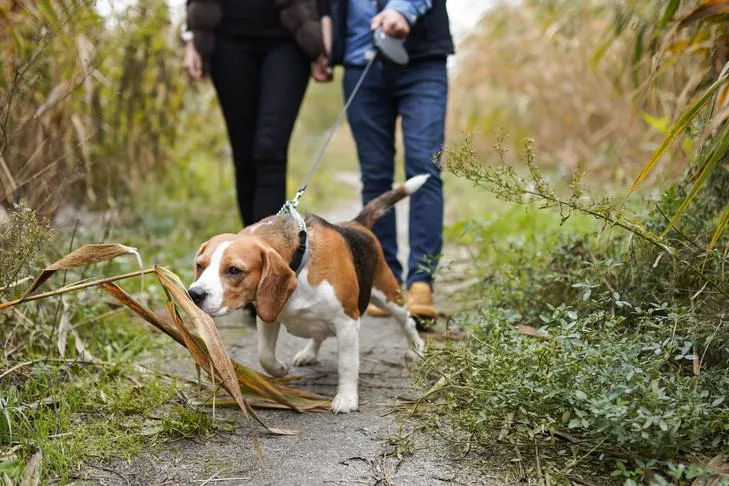Walking your dog should be an enjoyable and relaxing experience for both of you. However, for many dog owners, it quickly turns into a tug-of-war, with their beloved canine companion dragging them down the street. This common and often frustrating behavior, known as leash pulling, not only makes walks unpleasant but can also pose safety risks for both dog and owner. A large dog pulling hard can even lead to injuries. Understanding how to keep dogs from pulling when walking is crucial for a harmonious relationship and safer outings.
At Dog Care Story, we believe that every dog can learn to walk politely on a leash. While leash pulling is a prevalent issue, it’s highly treatable with consistent training and the right techniques. This comprehensive guide will show you exactly How To Train A Dog From Pulling When Walking, transforming your walks from a chore into a cherished bonding activity. By adopting these proven strategies, you’ll soon be enjoying calm, controlled strolls with your well-behaved companion.
1. Reward Good Leash Behavior Consistently
One of the most powerful tools in dog training is positive reinforcement. Dogs are smart, and they quickly learn that behaviors that lead to good outcomes are worth repeating. This applies directly to leash walking. If your dog walks nicely beside you without pulling, don’t take it for granted! Reinforce that desirable behavior immediately.
Rewards can come in many forms: a high-value treat, verbal praise (“Good walk!”), a gentle pat, or even the chance to sniff something interesting. In the initial stages of training, be generous and frequent with your rewards. As your dog’s understanding and skill improve, you can gradually reduce the frequency of tangible treats and incorporate more “life rewards” like a moment to explore a bush or a quick greeting with a friendly passerby. The key is for your dog to associate loose-leash walking with positive experiences.
2. Never Allow Your Dog to Progress While Pulling
The fundamental reason dogs pull on the leash is simple: they want to get to something – a scent, another dog, a destination – and pulling has historically gotten them closer. Therefore, to teach your dog that pulling is ineffective, you must never allow them to move forward when the leash is taut. This method is often called “the stop and go” or “be a tree” technique.
The moment your dog applies tension to the leash, immediately stop walking. Plant your feet firmly and become completely still. Do not move again until the leash goes slack. Your dog will eventually look back or adjust their position, wondering why the walk has halted. This pause breaks the pulling cycle and signals to your dog that pulling makes the walk stop, not continue.
 Two Basenji dogs, one on a leash, meeting in an open field, illustrating controlled dog interactions during leash training.
Two Basenji dogs, one on a leash, meeting in an open field, illustrating controlled dog interactions during leash training.
3. Wait for a Loose Leash Before Resuming Movement
After you’ve stopped due to pulling, knowing when to resume the walk is critical. The rule is simple: wait for a completely loose leash. This typically means the leash should hang in a relaxed “J-shape” and your dog should turn their attention, even for a split second, back towards you. This moment of attention is your cue.
When you see that slack leash and your dog looks your way, immediately offer praise and a treat right at your side. Then, calmly resume walking. In the beginning, you might find yourself stopping every few steps. This is normal and part of the learning process. With repetition, your dog will quickly understand that the only way to keep the walk going is to maintain a loose leash. Patience is paramount here; rushing this step will undermine your efforts.
4. Integrate “Life Rewards” into Walks
Beyond basic treats and praise, incorporating “life rewards” can significantly boost your dog’s motivation to walk politely. Life rewards are the everyday things your dog naturally enjoys, such as sniffing a lamppost, investigating a patch of grass, or greeting a person they know. By making these enjoyable activities conditional on good leash behavior, you make polite walking even more valuable.
For example, if your dog walks calmly for 10-20 feet without pulling, verbally praise them and then allow them a moment to sniff a specific area. Or, if they maintain a loose leash as you approach a friendly neighbor, allow a brief, controlled greeting. These bonus rewards deeply convince your dog that walking nicely pays off, as it grants them access to the very things they desire during a walk.
5. Maintain an Engaging Walking Pace
Often, humans walk at a pace that is far too slow for most dogs. Even small breeds have a naturally brisker gait than many people. Dogs tend to pull because they want to get moving and explore, and a slow pace can feel restrictive and boring to them. When training how do i train my dog to run with me, pace becomes even more critical.
While your dog can certainly learn to match your speed, choosing a slightly quicker, more purposeful pace during training sessions can make a big difference. A more engaging pace keeps your dog’s energy channeled forward and makes them feel more involved in the walk. This doesn’t mean you need to run, but aim for a brisk walk that feels comfortable for both of you, making it easier for your dog to learn not to leash pull.
6. Uphold the No-Pulling Rule Without Exception
Consistency is the cornerstone of effective dog training, especially when teaching [how to train a dog from pulling when walking]. It can be incredibly tempting to let your dog pull when you’re in a hurry, or when the weather is bad, and you just want to get their outdoor business done quickly. However, every single time you allow your dog to pull, you are inadvertently reinforcing the behavior and setting your training back significantly.
Your dog needs to understand that the “no-pulling” rule applies 100% of the time, regardless of the situation. Until your dog reliably walks on a loose leash for extended periods, prioritize training over distance or speed. If you only have a few minutes, let your dog relieve themselves in the yard and save dedicated walks for when you have the time and patience to reinforce polite leash manners.
 A determined Beagle dog straining on its leash to sniff the ground during an outdoor walk, highlighting common leash pulling behavior in dogs.
A determined Beagle dog straining on its leash to sniff the ground during an outdoor walk, highlighting common leash pulling behavior in dogs.
7. Keep Training Sessions Short, Positive, and Fun
Training a dog to stop pulling on the leash can be a frustrating process, especially with a determined puller. You might find yourself making very little progress in the beginning, perhaps only getting to the end of your driveway. The key is to manage your expectations and keep training sessions short, positive, and fun.
Dogs, particularly puppies, have limited attention spans. Asking too much too soon can lead to frustration for both of you and diminish your dog’s enthusiasm for learning. Instead of focusing on covering a certain distance, celebrate small victories – a few steps with a loose leash, a moment of eye contact. Aim for several short, upbeat sessions throughout the day rather than one long, grueling one. Remember, the goal isn’t to walk a mile, it’s to walk politely, even if it’s just to the next mailbox. This approach helps teach how to get your dog to not jump as well, by fostering an overall positive training environment.
8. Be an Engaging and Interactive Walker
For your dog, the world outside is an overwhelming sensory experience – a riot of new sights, sounds, and most importantly, smells. These distractions constantly compete for your dog’s attention and can easily lead to pulling. If you’re disengaged, perhaps focused on your phone, there’s little incentive for your dog to pay attention to you.
To counteract external distractions, you need to become the most interesting thing on the walk. Talk to your dog in an upbeat tone, give them unexpected treats, take quick breaks for a game of “find it” in the grass, or practice a simple “sit” or “stay.” By being unpredictable and engaging, you keep your dog guessing and focused on what you might do next, making them more likely to follow your lead rather than the scent of a squirrel.
9. Practice Calmness and Emotional Control
Dogs are incredibly adept at reading human emotions. Your mood can travel right down the leash and profoundly impact your dog’s behavior. Whether you encounter a friend, another dog, or something that causes your dog anxiety, your emotional response can either escalate or de-escalate the situation. If you become tense or anxious, your dog will often mirror that feeling, potentially intensifying their pulling or fear responses.
To help your dog stay calm and focused during walks, it’s essential that you remain calm yourself. Speak in a soothing voice, maintain a relaxed grip on the leash, and project an air of confidence. This reassures your dog that there’s nothing to be overly excited or worried about, making them more receptive to your commands and better able to behave appropriately.
 A calm Cavalier King Charles Spaniel walking politely on a lead outdoors, demonstrating good leash manners.
A calm Cavalier King Charles Spaniel walking politely on a lead outdoors, demonstrating good leash manners.
10. Actively Engage Your Dog During Distractions
Distractions are inevitable on walks. Other dogs, squirrels, unfamiliar people, or sudden noises can easily cause your dog to forget their leash manners and start pulling. Your dog might pull to investigate something exciting or pull away from something they perceive as threatening. In either scenario, polite walking often goes out the window.
The key to managing distractions is to proactively engage your dog before they become overwhelmed. As soon as you spot a potential distraction, gently redirect your dog’s attention to you. You can do this by offering high-value treats, playing a quick, engaging game, or asking for a simple command like “sit” or a “hand target.” Teach your dog a “watch me” cue to establish eye contact, allowing you to control where they focus their attention. The goal is to capture their focus before the distraction becomes too strong, often making it so they barely notice the distraction at all. This is also a good strategy for how to get your dog to bark naturally in appropriate contexts, by maintaining focus on you. Mastering these techniques will empower you to how to stop a dog from pulling on its leash effectively in any situation.
Learning how to train a dog from pulling when walking requires consistency, patience, and a positive approach. By implementing these ten essential tips, you can transform your walks into a pleasant and rewarding experience for both you and your canine companion. Remember to celebrate every small victory, remain calm and consistent, and make every walk an engaging experience. With dedication, you’ll soon enjoy peaceful, loose-leash walks and a stronger bond with your dog. Start your training journey today and unlock the joy of harmonious walks!
